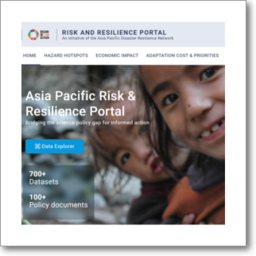Asia and the Pacific is the most disaster prone region in the world. A person living in the region is almost twice as likely to be affected by a disaster as a person living in Africa, almost six times as likely compared with Latin America and the Caribbean, and 30 times more likely than a person living in North America or Europe. In 2013 alone, natural disasters in Asia and the Pacific affected more than 57 million people and caused US $128 billion in damages. Rapid economic growth and population expansion over the coming decades, along with the impacts of climate change, will increase the exposure and vulnerability of the region to disasters. As disasters disrupt all sectors of the economy and destroy hard-earned development gains, it is crucial that effective disaster risk reduction measures are integrated into development plans and poverty reduction strategies.
At the same time, technological innovations provide unprecedented opportunities to build resilience and deepen connectivity. Experiences from the region and around the world have proven that disaster prevention and preparedness, enabled by communication and space technologies, can be far more effective and less costly than ever before. Space technologies have proven highly effective in disaster monitoring, early warning, and emergency response efforts. For example, ESCAP’s Regional Cooperative Mechanism for Drought Monitoring and Early Warning enhances the capacity of governments to use space-based data for effective drought monitoring, allowing countries to issue early warnings before a drought is visible to the human eye. Meanwhile, the ESCAP Multi-Donor Trust Fund for Tsunami, Disaster and Climate Preparedness in Indian Ocean and Southeast Asian countries, strengthens the capacities of Member States in multi-hazard early warning and coastal resilience building.
Despite the great progress in deepening regional connectivity through information and communication technologies, Asia and the Pacific is still the most digitally divided region in the world, with less than eight per cent of the population connected to affordable and reliable high-speed Internet. As a result, millions of people are shut out from transformative digital opportunities in education, health and financial services. Women and girls, in particular, have lower levels of access to broadband Internet and other knowledge-enhancing technologies. The Asian Information Superhighway initiative aims to increase the availability and affordability of broadband Internet for all people across Asia and the Pacific.
Through evidence-based policy analysis, capacity-building, and demand driven regional advisory services, ESCAP supports member States to build resilience and deepen connectivity. Our efforts are focused on strengthening regional cooperation for sustainable development, and our approach is based on multidisciplinary analysis and multi-stakeholder partnerships.

















